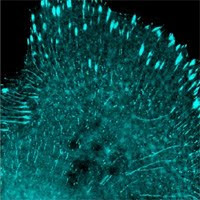The advantages of camelid antibodies with only the heavy chains have been exploited for therapeutic use or as novel research tools such as immunoprecipitation trap (e.g. GFP-Trap). These so-called nanobodies are small in size (14-15kD), highly stable, and capable of binding to epitopes that traditional antibodies are normally not able to bind. Doyle et al. published a paper in JBC last week demonstrating that when expressed inside cells (intrabody), the VHH fragment can provide antitoxicity protection against deoxynivalenol (DON) or 15-acetyl0deoxynivalenal (15-AcDON), common toxins involved in agriculture infection Fusarium.
Camelid antibodies against low molecular weight 15-AcDON were isolated by immunizing llama with 15-AcDON-BSA protein conjugate as published earlier by the same group of researchers in Canada. As demonstrated previously, the small nanobody derived from camelid antibody can be highly expressed inside target cells without causing much cytotoxicity by itself. Images generated by confocal immuno-microscopy showed that VHH is evenly distributed throughout the cytosol. The antitoxin effects were specific, effective, and apparently dose-dependent.
This report, albeit using a yeast model system instead of natural targets of the relevant plant disease, opens doors to increased tests of using VHH fragments for broader applications in agriculture and more fields other than therapeutics.
Doyle et al. 09-2009
http://www.jbc.org/cgi/doi/10.1074/jbc.M109.045047
Subscribe to:
Post Comments (Atom)




No comments:
Post a Comment